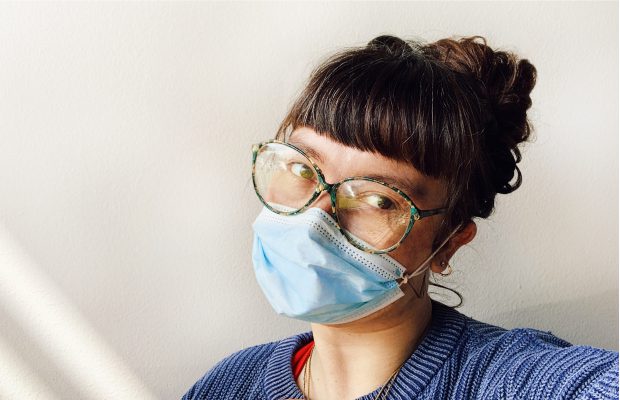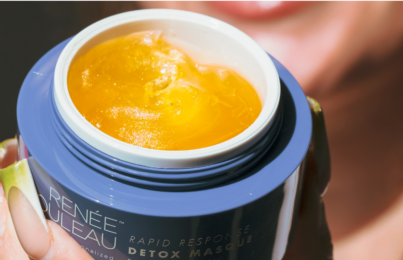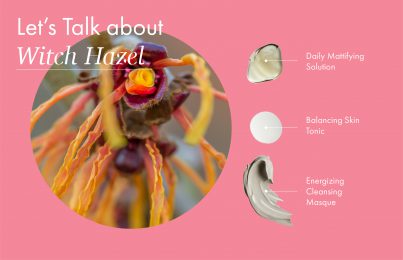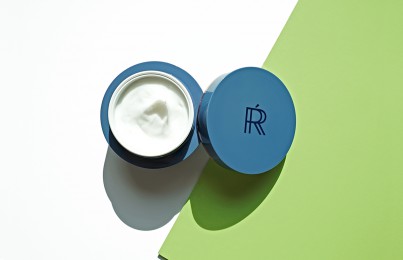Updated 10/05/21. While medical professionals may be used to wearing protective face masks every day, they have only recently become a part of everyday life for the rest of us as well. Since then, I’ve been getting a lot of questions about the changes people are seeing in their skin as a result. The most common complaints I hear about are increased breakout activity and sensitivity or irritation. Keeping reading to learn how to mitigate the negative effects of wearing a protective face mask.
How Do Protective Face Masks Cause Breakouts?
Wearing a mask or other protective gear around your face can lead to a type of acne called acne mechanica. The only difference between these types of breakouts and regular breakouts is the cause. While regular breakouts tend to be hormonally driven, acne mechanica is caused by friction (a physical disruption to the skin). When something is constantly rubbing against your skin, the combination of friction, heat, and pressure can trigger breakouts. This is especially true if you’re wearing a protective mask while you work out. Athletic equipment is already notorious for causing acne mechanica thanks to a combination of synthetic fabric, sweat, and movement.
In addition to friction, a mask that covers your mouth can cause breakouts because of the moist environment it creates. Your breath traps moisture and heat, which stimulates oil flow. This combo of oil, heat, and moisture is a perfect breeding ground for bacteria.
Another reason protective face masks can cause breakouts is the pressure they exert on your pores. You may notice that, after removing a mask, you have indents on your skin. These indents could actually be changing the shape of your pores, causing a buildup of oil. Imagine your pores as a network of tubes under your skin that funnels oil to the surface. Oil is meant to flow freely through these tubes, but if they become kinked or bent from pressure, oil gets stuck.
How Can I Prevent Breakouts Caused by Face Masks?
The goal is to create an environment in which “bad” bacteria won’t thrive. This comes down to two things. The first is reducing oil production. The second is using ingredients with blemish-fighting properties. Here are five ways to do just that.
1. Use the Right Kind of Toner
If you’re wearing a protective face mask for a long period of time, I recommend applying toner over the affected area once or twice a day. Not just any toner, though. I recommend a toner that contains ingredients with blemish-fighting properties. These ingredients include salicylic acid, lactic acid, and tea tree oil—all of which are included in the Rapid Response Maskne Spray. With the same formulation as the Rapid Response Detox Toner, this spray can help clear clogged pores and keep bacteria at bay. Simply spray it on the skin under your mask every four hours for blemish-fighting benefits.
No matter what, make sure the toner you choose to use is non-drying and alcohol-free. Drying out the skin with alcohol can actually lead to more oil production. That’s the opposite of what you want. (If you want to learn more about the science behind breakouts, click here).
2. Reset the Skin at Night
Washing your face before bed is always important. When you’ve spent all day wearing a face covering that traps heat, sweat, oil, and bacteria, it’s especially important. Use your nighttime routine as an opportunity to really reset your skin.
If you’re worried about breakouts as a result of wearing a face mask, the most important thing you can do is be diligent about your skincare routine. Trust me, it’s a lot easier to stay on top of the problem than it is to try to fix it once things have gotten out of hand. Start by washing your skin with a cleanser that contains ingredients like salicylic acid or tea tree extract, such as the Renée Rouleau Rapid Response Detox Cleanser. It also contains kaolin clay to absorb built-up oil and other impurities.
After cleansing, I suggest applying a masque (the fun kind this time!). Look for one like the Renée Rouleau Rapid Response Detox Masque. Its blemish-fighting properties kick in after just five minutes while hydrating ingredients soothe the skin to counteract the friction caused by protective face masks.
3. Use a Serum With Salicylic Acid
I recommend using a serum with salicylic acid two to three nights a week. Salicylic acid is unique because it can cut through oil and get into the pore lining. Remember that face coverings trap oil in your pores by exerting pressure on them and creating indentations in the skin (which can change the shape of pores). Salicylic acid has the ability to get into the pores to clear out oil build-up so it doesn’t turn into a full-on breakout.
4. Try a Mineral Sunscreen Powder
Even if you work indoors, you should be wearing sunscreen every day to protect your skin from UV damage. Unfortunately, sunscreens are notorious for causing breakouts and clogged pores. If you’re already struggling to keep your skin clear while wearing a protective face mask, you may want to opt for a mineral sunscreen powder instead of a traditional lotion- or cream-based sunscreen.
Mineral powders are easy to touch up during the day, especially if you’re wiping the skin down with a toner. They also sit on top of the skin instead of settling into pores, which is why they’re far less likely to cause blemishes. As an added bonus, powders will absorb excess oil that sits on the skin.
5. Regularly Wash Your Protective Face Masks
If you’re wearing a reusable face covering when you go out, be sure to wash it regularly. This is the best practice for hygiene. It can also keep oil and dirt from being reintroduced onto the skin.
How Do Protective Face Masks Cause Irritation?
The friction that’s responsible for acne mechanica is also the culprit behind most irritation caused by protective face masks. In fact, red, bumpy, rashy skin is a common precursor to acne mechanica. All of these are signs of inflammation, which can wake up your skin’s pigment cells and cause lingering pigmentation long after the erythema (redness) has subsided. To avoid this, it’s best to address irritation right away.
When something is consistently being rubbed across your skin, it can disrupt your moisture barrier. Your moisture barrier is made up of lipids that keep moisture in and irritants out. If something is rubbing against your skin all day, it can create tiny cracks in your barrier. This allows moisture to escape and irritants to enter. A common symptom of a damaged barrier is that products that usually don’t sting your skin suddenly do. If you’re experiencing this, your moisture barrier may be compromised.
How Can I Prevent Irritation Caused by Protective Face Masks?
The most important thing to focus on when addressing irritation is keeping the skin protected and hydrated. Here are four ways to do that.
1. Use a Serum-Infused Toner Throughout the Day
If irritated, rashy skin is your concern, try using a hydrating, serum-infused toner, like the Renée Rouleau Moisture Infusion Toner. I think of this toner as more of an ‘essence’ because it pampers and soothes thirsty skin cells by delivering moisture deep into the skin. Doing this a few times a day will remove dirt and oil buildup while simultaneously soothing the skin. Be sure to apply a little moisturizer on top to seal everything in.
2. Use a Cooling Gel Masque Before Bed
Start your evening routine by using a non-foaming lotion or gel cleanser to remove oil and debris from the skin. Massage thoroughly (but gently) to break down any sunscreen or makeup you were wearing. Once your skin is clean, I suggest applying a cooling, gel-based masque, such as the Renée Rouleau Bio Calm Repair Masque. These gel masques tend to be the most soothing thanks to their naturally cooler temperatures. You can even stash it in the fridge for an extra comforting treat!
3. Avoid Over-Exfoliation
When the skin is irritated, the last thing you want to do is aggravate it even more. Be cautious when it comes to using exfoliating acids. The purpose of these is to slough dead cells off the surface of your skin, which a face masque is already doing by the manual motion of rubbing back and forth. Adding in even more exfoliation could be too much. Listen to your skin and pull back if it seems like too much.
I also recommend staying away from physical exfoliants like face scrubs and sonic cleansing brushes when your skin is irritated. Physical exfoliation is already harder on the skin than chemical exfoliation. In this case, adding even more friction by scrubbing your face certainly won’t do you any favors.
4. Use a Moisturizer With Soothing Ingredients
To focus on rebuilding and protecting your skin’s protective moisture barrier, use a moisturizer with reparative ingredients. A few of my favorites include shea butter, tocopherol, and sunflower oil. Also, keep an eye out for the addition of ingredients that can soothe skin. These include chamomile, white tea, ascorbyl palmitate, and oat kernel extract.
If you’re worried about heavy moisturizers breaking you out, I recommend using something like the Renée Rouleau Skin Recovery Lotion. I also recommend avoiding any moisturizers with high percentages of essential oils or any kind of synthetic fragrance. Both of these are notorious for irritating the skin and can break your moisture barrier down over time.
Whether you wear a mask on the job or are wearing one in public to do your part, I hope you find these tips helpful! Wishing everyone good health. XX Renée
Next, check out a complete guide to clearing clogged pores, once and for all.
Celebrity Esthetician & Skincare Expert
As an esthetician trained in cosmetic chemistry, Renée Rouleau has spent 35 years researching skin, educating her audience, and building an award-winning line of products. Her hands-on experience as an esthetician and trusted skin care expert has created a real-world solution — products that are formulated for nine different types of skin so your face will get exactly what it needs to look and feel its best. Trusted by celebrities, editors, bloggers, and skincare obsessives around the globe, her vast real-world knowledge and constant research are why Marie Claire calls her “the most passionate skin practitioner we know.”




Comments:
My boys (ages 7 and 10) are now wearing masks all day at school and are starting to have some irritation. I do put the daily sunscreen on them and have for awhile. What cleanser and/or toner can I get for them? I use the rapid response cleaner and the detox mask but wanted to check in before I start using products on their young skin! Thanks!
Posted By: Allison |
Hey there! I would suggest the boys try Moisture Protecting Cleanser and Phytolipid Comfort Creme to help restore their fragile skin from the constant friction of the mask!
Posted By: Renée Rouleau |